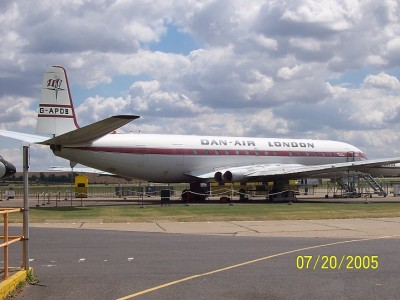De Havilland Comet
The De Havilland Comet was the first commercial mass-produced jet transport aircraft. The first flight of this type took place in 1949, and the first "service flight" for BOAC took place in 1952. The first versions were "famous" for a series of tragic accidents caused by metal fatigue, but the latest version, the Comet 4, has already overcome all that and remained in service for over thirty years.
Variants:
Comet 1 - the first production version with de Havilland Ghost engines, later modified after a wave of accidents to become Comet 1A and Comet 1XB with a reinforced fuselage.
Comet 2 - had a slightly enlarged wing and fuel supply, production began in 1953. In 1955, ten machines were taken over by the RAF from BOAC, which was not satisfied with the range, as the Comet C.2 (eight machines, transport, had reinforced floors) and Comet T.2 (two machines, for crew training). Probably three C.2 machines were converted to the Comet 2R variant (or C.2R), which had an unpressurized hull and was in service with the 51st Electronic Reconnaissance Squadron from 1957. All military Comet 2s used Avon Mk117/118 engines.
Comet 2X - a prototype of version 2, built from Comet 1 by swapping the engines for the more powerful Rolls-Royce Avon 502
Comet 2E - a modification of the two remaining BOAC machines, with Rolls-Royce Avon 504 engines on the inside and Rolls-Royce Avon 524 engines on the outside.
Comet 3 - a version with an extended fuselage, but production of this was discontinued and the two built were used to test the technology of version 4
Comet 4 - a development of version 3, it had a higher tank and passenger capacity. It was used by BOAC for transatlantic flights (which previous versions were not capable of). Later, variants Comet 4A (designed for short routes, with extended fuselage and shorter wings) and Comet 4B (with even more extended fuselage, same short wings) were created. This was the basis for the Comet 4C variant, which had the long fuselage of the 4B and the wings of the original Comet 4. This variant first flew in 1959. It was the basis for the naval patrol aircraft Hawker Siddeley Nimrod.
The RAF used Comet aircraft with three squadrons - the Comet C.2 and 2R flew with the 51st Squadron from 1958-1975, as well as briefly (1957-1958) with the 192nd Squadron.
216th Squadron used the Comet C.2 and Comet C.4 (five machines, a transport variant of the Comet 4C version) in 1956-1975. Other machines were with the RAE and were also flown (actually the first) by the 412th Squadron of the RCAF, which used two Comet 1As, later modified to the 1XB version, from 1953-1963.
Source:
http://en.wikipedia.org/wiki/De_Havilland_Comet
www.geocities.com
www.geocities.com
www.aerospaceweb.org
website.lineone.net/~redgoose/history.htm
The De Havilland Comet was the first commercial mass-produced jet transport aircraft. The first flight of this type took place in 1949, and the first "service flight" for BOAC took place in 1952. The first versions were "famous" for a series of tragic accidents caused by metal fatigue, but the latest version, the Comet 4, has already overcome all that and remained in service for over thirty years.
Variants:
Comet 1 - the first production version with de Havilland Ghost engines, later modified after a wave of accidents to become Comet 1A and Comet 1XB with a reinforced fuselage.
Comet 2 - had a slightly enlarged wing and fuel supply, production began in 1953. In 1955, ten machines were taken over by the RAF from BOAC, which was not satisfied with the range, as the Comet C.2 (eight machines, transport, had reinforced floors) and Comet T.2 (two machines, for crew training). Probably three C.2 machines were converted to the Comet 2R variant (or C.2R), which had an unpressurized hull and was in service with the 51st Electronic Reconnaissance Squadron from 1957. All military Comet 2s used Avon Mk117/118 engines.
Comet 2X - a prototype of version 2, built from Comet 1 by swapping the engines for the more powerful Rolls-Royce Avon 502
Comet 2E - a modification of the two remaining BOAC machines, with Rolls-Royce Avon 504 engines on the inside and Rolls-Royce Avon 524 engines on the outside.
Comet 3 - a version with an extended fuselage, but production of this was discontinued and the two built were used to test the technology of version 4
Comet 4 - a development of version 3, it had a higher tank and passenger capacity. It was used by BOAC for transatlantic flights (which previous versions were not capable of). Later, variants Comet 4A (designed for short routes, with extended fuselage and shorter wings) and Comet 4B (with even more extended fuselage, same short wings) were created. This was the basis for the Comet 4C variant, which had the long fuselage of the 4B and the wings of the original Comet 4. This variant first flew in 1959. It was the basis for the naval patrol aircraft Hawker Siddeley Nimrod.
The RAF used Comet aircraft with three squadrons - the Comet C.2 and 2R flew with the 51st Squadron from 1958-1975, as well as briefly (1957-1958) with the 192nd Squadron.
216th Squadron used the Comet C.2 and Comet C.4 (five machines, a transport variant of the Comet 4C version) in 1956-1975. Other machines were with the RAE and were also flown (actually the first) by the 412th Squadron of the RCAF, which used two Comet 1As, later modified to the 1XB version, from 1953-1963.
Source:
http://en.wikipedia.org/wiki/De_Havilland_Comet
www.geocities.com
www.geocities.com
www.aerospaceweb.org
website.lineone.net/~redgoose/history.htm

